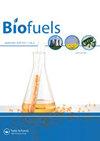从帝王狄龙尼豆荚中提取生物炭:对上升气流蒸馏碳化过程的考虑
IF 2.6
4区 工程技术
Q3 ENERGY & FUELS
引用次数: 1
摘要
碳化是一项特别适合撒哈拉以南非洲地区能源转换挑战的新技术。本研究旨在通过蒸馏炉碳化工艺从龙葵豆荚(DRP)中生产和表征生物炭。在峰值温度为375℃,处理时间为150 min的条件下,得到的龙蚌豆荚生物炭(DRPB)产率为29.48 wt%。DRPB的平均孔体积为0.0352 cm3/g,比表面积为88.03 m2/g,平均孔径为1.6 nm。形态学分析表明,DRPB表面形貌不均匀,平均粗糙度为12.96 × 103µm。生物炭中存在C-O、N-O、O- h、C = O、CO-O和C- h等官能团。与其它蒸馏碳化生物炭相比,DRPB具有较好的性能。基于生物炭的特性,还讨论了潜在的应用,该产品可用于水处理应用和作为改善润滑油摩擦学和流变学性能的添加剂。关键词:生物炭,生物质,废弃物,碳化,delonix地区,能源,致谢第一作者要感谢所有以前从事过蒸馏炉碳化技术的作者,特别是J. C. Adam[引文37],他是该领域的先驱之一。他们为当前的研究提供了良好的理论平台,使我们真正站在了巨人的肩膀上。作者的贡献所有作者都对研究的构思和设计做出了贡献。采用JOI、SO和CAA进行材料准备、数据收集和分析。手稿的初稿是由JOI撰写的,所有作者都对手稿的前几个版本进行了评论。所有作者都阅读并批准了最终的手稿。数据和材料的可用性通讯作者可要求提供所有数据。声明作者声明不存在利益冲突。本文章由计算机程序翻译,如有差异,请以英文原文为准。
Biochar from Delonix regia pod: consideration of an updraft retort carbonisation process
AbstractRetort carbonisation is a novel technology especially suited to the sub-Saharan Africa energy conversion challenges. This study aims to produce and characterise biochar from Delonix Regia pod (DRP) via the retort carbonisation process. The process achieved a Delonix Regia pod biochar (DRPB) yield of 29.48 wt% at a peak temperature of 375 °C and a process time of 150 min. The average pore volume, specific surface area, and average pore size of DRPB were 0.0352 cm3/g, 88.03 m2/g, and 1.6 nm, respectively. Morphological analysis revealed that DRPB had a heterogeneous surface morphology with an average roughness of 12.96 × 103 µm. Functional groups such as C-O, N-O, O-H, C = O, CO-O, and C-H are present in the biochar. DRPB compares well with other retort carbonisation biochar. Potential applications were also discussed based on the biochar properties and the product can be tested for water treatment applications and as an additive for improving the tribological and rheological properties of lubricating oils.Keywords: Biocharbiomass wastecarbonisationDelonix regiaenergy AcknowledgementsThe first author wishes to acknowledge all authors who have worked previously on retort carbonisation technology, especially J. C. Adam [Citation37] one of the pioneers in the field. They have provided a sound theoretical platform for the current investigation, hence making us truly stand on the shoulder of giants.Authors’ contributionsAll authors contributed to the study conception and design. Material preparation, data collection and analysis were performed by JOI, SO and CAA. The first draft of the manuscript was written by JOI and all authors commented on previous versions of the manuscript. All authors read and approved the final manuscript.Availability of data and materialsAll data are available on request to the corresponding author.Disclosure statementThe authors declare that there are no conflicts of interest.
求助全文
通过发布文献求助,成功后即可免费获取论文全文。
去求助
来源期刊

Biofuels-Uk
Energy-Renewable Energy, Sustainability and the Environment
CiteScore
5.40
自引率
9.50%
发文量
56
期刊介绍:
Current energy systems need a vast transformation to meet the key demands of the 21st century: reduced environmental impact, economic viability and efficiency. An essential part of this energy revolution is bioenergy.
The movement towards widespread implementation of first generation biofuels is still in its infancy, requiring continued evaluation and improvement to be fully realised. Problems with current bioenergy strategies, for example competition over land use for food crops, do not yet have satisfactory solutions. The second generation of biofuels, based around cellulosic ethanol, are now in development and are opening up new possibilities for future energy generation. Recent advances in genetics have pioneered research into designer fuels and sources such as algae have been revealed as untapped bioenergy resources.
As global energy requirements change and grow, it is crucial that all aspects of the bioenergy production process are streamlined and improved, from the design of more efficient biorefineries to research into biohydrogen as an energy carrier. Current energy infrastructures need to be adapted and changed to fulfil the promises of biomass for power generation.
Biofuels provides a forum for all stakeholders in the bioenergy sector, featuring review articles, original research, commentaries, news, research and development spotlights, interviews with key opinion leaders and much more, with a view to establishing an international community of bioenergy communication.
As biofuel research continues at an unprecedented rate, the development of new feedstocks and improvements in bioenergy production processes provide the key to the transformation of biomass into a global energy resource. With the twin threats of climate change and depleted fossil fuel reserves looming, it is vitally important that research communities are mobilized to fully realize the potential of bioenergy.
 求助内容:
求助内容: 应助结果提醒方式:
应助结果提醒方式:


